In this chat led by Alison Wagonfeld of Emergence Capital, we tap into the combined wisdom of serial entrepreneurs and formal rivals David Cancel, Founder & CEO of Drift, and Hiten Shah, Co-founder of Quick Sprout, on the rocky journey towards product/market fit.
As product-focused founders and previous competitors, David and Hiten share their painful lessons, often with differing perspectives, in the pursuit of the illusive product/market fit. As repeat founders, is it better to fundraise before or after finding product/market fit? How do you know when you’re there, and what are the key indicators that the market has evolved to threaten that fit? Early on, is it better to keep hiring on the product team or should you build up your sales and marketing teams sooner? David and Hiten do, however, agree that is critically important to always assume your are wrong and be deliberate about your learnings, as well as the importance of having everyone, including engineering, do customer support.
If you want to see more sessions from 2016, we’re releasing a new one each week. Subscribe here to be notified. And be sure to grab your tickets to the 2017 Annual NOW.
Transcript
Alison Wagonfeld: Hi. Welcome everyone. My name is Alison Wagonfeld. I’m an operating partner at Emergence Capital, a venture firm focused on enterprise cloud companies.
I’m excited to help emcee, moderate, a fantastic session that we have now about product/market fit, what that looks like, what it means to have elusive product/market fit, what is real product/market fit. We have two great speakers, and then we’ll have time for a couple of questions at the end.
I wish I could say that there were seats in front, but there are not, unless you want to sit down up here. I’m sorry about that.
Let me start by welcoming our two fantastic people with extensive product experience. Hiten Shah is going to come on up, and David Cancel. Hiten you might know because he writes a fantastic blog about SaaS. You’ve probably seen that, or if you haven’t, you should follow it.
David, previously of KISSmetrics, but he’s going to walk you through his background. David Cancel, in from Boston, background, previously at HubSpot, but now founder and CEO of Drift. He can walk you through that.
After they both introduce themselves, we’ll dig into questions related to product, and then we can have some time to talk about competition. I learned a few minutes ago, that they previously competed with each other.
We might have time a little bit to talk about funding environments, because they have different perspectives on how fundraising impacts the search for product/market fit. With that I’m going to turn it over to Hiten. He’s going to give us some background about himself. Take it away.
Hiten Shah: My turn?
Alison: Yes, your turn.
Hiten: Hi everybody, I’ve built a whole bunch of SaaS products. There’s a few you probably know. Crazy Egg, about 11, 12 years ago, and then KISSmetrics, we started about 8 years ago. I just recently started a new company called Quick Sprout.
They’ve all been SaaS and probably built myself, 20 different SaaS products, with our teams over the last 13 years.
Alison: David?
David Cancel: Hi. David Cancel, and I want to show this slide to my friends at Matrix because it says I’m a GP at Matrix.
[laughter]
Hiten: You’re a VC now? I didn’t know that happened, congratulations.
David: Thanks. I’m on my fifth company now, it’s called Drift, and before that, my first company was called Compete, which started in 2000, got acquired. I started a company called Lookery, and then later a company that’s out there presenting in a booth called Ghostery, and right after that, a company called Performable, which was acquired by HubSpot.
I went to HubSpot and ran product engineering, design, and all that stuff, for three and a half years, left there to started my latest company. Hiten and I used to compete at one point.
Hiten: That’s right.
Alison: Before we get started in some of the topics, by show of hands, how many of you head up a product organization within your companies? How many of you are founders? Thanks, that’s helpful.
Let’s start on the positive side. David, maybe you can lead us off. When have you really felt that you’ve hit product/market fit? Give us an example from one of your companies. What were the signs that you looked at to get that sense?
David: They’re elusive. The easiest thing, all my companies have been in B2B world. It’s a lot easier to determine fit.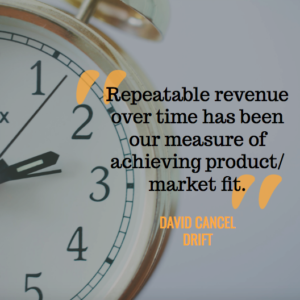
For us, it’s really been revenue. Revenue’s been our measure. Not really number of customers, but when we’re getting repeatable revenue over time has been that moment of realization of saying, “We’re on to something, here.”
It’s repeatable. We’re getting revenue. It’s becoming easier and easier. For us, it’s easy. It’s money.
Alison: How much revenue?
David: Doesn’t matter. In come cases, in some of my companies, we would do things for ridiculously low revenue. The difference, for me, is getting someone to use something for free versus getting them to give you two dollars is a big chasm. Not a lot of people want to cross that.
For us, it could be as simple as getting $10 a month from them, from a SaaS perspective, just making sure that they were willing to pay.
Alison: Willingness to pay is up there as number one. Hiten, what about you?
Hiten: I think willingness to pay is great. Many of you might be wondering, “What do you do if you’re not asking for payment, yet?” If you’re like me, and you like building freemium products, or you’re in an early access period, you’re trying to get to product/market fit without charging.
The thing I look for is, on product, usually, you’ve created something with a bunch of criteria in mind about how it’s going to solve a problem. The first thing I look for is inbound emails, tweets, and things like that that reflect that we are solving the problem.
Back in the day, with KISSmetrics, we created a new way to visualize funnels that was retroactive. It took data from the past. You could build the funnels out on the fly.
We didn’t even use a lot of that language in our product, but the tweets we would get, once we felt like we had product/market fit, were all aligned around that value prop that we were hitting.
There was so many of them it was hard to keep up, at some point. That was the first time that I would look for an indicator, which is, basically, some unsolicited feedback, word of mouth, Twitter, Facebook, even support requests, emails coming in with love, an alignment of solving the problem that your product is supposed to solve.
Alison: David, I’ve seen a quote that you wrote about. When thinking about product/market fit, assume that you’re wrong. Expand on that. What do you mean by that, and how does that manifest itself inside a company?
David: I think about that in always creating products, and even creating companies. For us, it’s always been putting the ego to the side, having this humility to recognize that most of the things that you’re going to build from a featured product, even company standpoint, are wrong, and what you’re trying to do is get out there as quickly as possible to validate those things.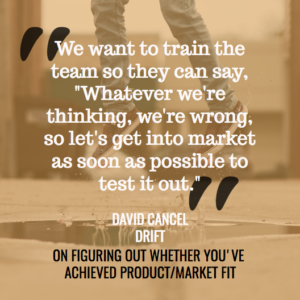
That doesn’t stop once you hit fit. It continues every time you’re building, and adding to your product. We want to get everyone on the team trained around like, “Whatever we’re thinking, we’re wrong.” We may be 5 percent wrong or off, or we might be 100 percent off. Let’s get into market as soon as possible to test this thing,
Alison: Got it. What is something where you’ve truly been wrong? Give us an example.
David: I’m wrong almost every day. [laughs]
Alison: Give us an example on a product where you just kind of, “We missed the mark.”
David: I’d say back in Performable, we started out on a landing page side, and we were really wrong on who we thought our buyer was going to be. We were going more SMB non-marketer, and it turned out that the persona was wrong, that it was really a marketer.
[crosstalk]
Alison: How did you figure that out?
David: Painfully. On one end, back to what Hiten was saying, just the things that they were saying that we were solving was different from what we thought we were going to solve. It was painful from a support standpoint, painful from lots of different areas. Then we had some marketers who used it by accident, and what they were saying back to us was what we thought we were solving, so kind of led us that way.
Alison: Interesting. Hiten, how about for you? A time where you kind of haven’t hit it right, how did you know, and what did you do to switch?
Hiten: This one was painful. At KISSmetrics, we invented a new way to do funnels that’s very popular now, and it was right. We couldn’t see past that, and then David came around and said, “Screw your funnel. Here’s a better way to do it.”
The reason I say that we were wrong is because this is one of the things about product/market fit, that it changes as new things come into your market that are solving problems for your customers.
We had it, then it ended up being an illusion that we had it, once something better came in, and started cutting at our customer base, because they started using KISSmetrics, and Performable at that time for very similar use cases. Performable in certain categories was actually doing a better job than we were.
For us, the biggest learning is that it goes away, and paying attention to the market and what your customers are switching to, and coming and switching to and from your product is really important. Once we noticed that, I personally had a terrible time, because I don’t want to ever compete with him.
Alison: David, when you were building Performable, were you trying to take on KISS? Were they in your sights of how you were building your products?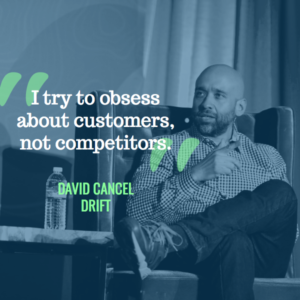
David: [laughs] A little bit. I’d say a little. We try to obsess. My version of the story is I try to obsess around customers and not competitors. We were just listening to customers saying that their funnel wasn’t linear, wasn’t this thing that you could just predefine, and pre setup.
We really focused on events, and being able to have things that happen in the natural world. You have different entry points and exit points. How do you stitch those things together? My version is customer driven although, yes I was looking at Hiten a little bit.
Alison: What? [laughs]
Hiten: They were hiding features from us.
David: Yeah.
Hiten: We’re friends, so this was very friendly competition. There were features they were hiding. We would go get, once every six weeks, on a sales call with some company or friend that’s talking to Performable, so we could understand what they were doing.
We weren’t obsessed with them as a competition. We were obsessed with what he said. He tends to focus so much on the customer, he doesn’t care what he has to do as long as it’s solving customer problems, and that’s scary because it’s hard to focus on customers all the time.
He has to assume he’s wrong and all this kind of stuff. At the time, we didn’t know how to do that as well, and the way we had built our product was solving a big problem that funnels had.
We couldn’t see past that very easily, because we were actually at product/market fit at the time, and then he came in and almost sideswiped. We weren’t as focused on the customer, truthfully, as he was. That’s why I say it’s scary to compete with him.
Alison: In a few minutes, we’ll talk about each of your new companies, so you can project about what…
[laughter]
David: Yeah.
Hiten: It’s OK.
David: Are we competing?
Alison: Horse’s mouth. No longer competitive, right?
Hiten: No, no. Not at all.
Alison: Now you can share liberally.
Hiten: Thank you. Please don’t compete, OK?
David: Yeah.
Alison: One of the challenges that comes up about looking at customers that pay you as evidence of product/market fit is that, are these customers really arm’s-length agreements. Are they customers that know you? How many concentric circles away from you are they?
How do you think about that so that you have confidence that these are not friends and family, and others in VC backed companies? There’s a lot of people in in this room, so these would probably be great customers, [laughs] thinking about that?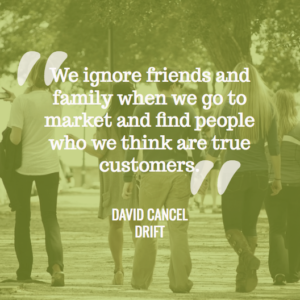
David: For us, we’ve done it the same way last couple of times, both Performable and Drift, where we know a lot of people. We have a big waiting list. Those are all friends, the kind of people you’re talking about. We ended up going to market ignoring that. That almost becomes the ignore list.
We go into market with a very different customer, and then later on, bring in those folks. We actively try to avoid those people. We go to try to find someone else who we think is a true customer.
Alison: Great. That’s helpful. Hiten, how do you think about that?
Hiten: There’s a lot of bias in friends, like David was saying. One thing I’ll say is I don’t mind having a friend use our products. Having them pay for it because they’re a friend is a problem, so I think your strategy on avoiding it is great.
For me though, I actually don’t focus on revenue as a product/market fit indicator early on. I focus on retention as a product/market fit indicator. The kind of businesses him and I make tend to be a little bit different from a SaaS perspective. The money question, usually when we already have retention and then start charging for it, naturally it’s people that are already using it, regardless of who they are.
Also, purposefully, tend not to do the same thing, which is don’t reach out to friends, unless they reach out to us when they see some of the stuff we’re doing.
Alison: Unless they tweet really nice things.
Hiten: Then, it’s like theater, so that’s dangerous, but yeah.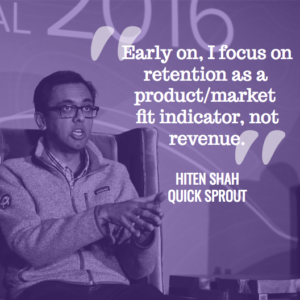
[laughter]
Alison: Let’s dig into your current companies. You both have started new companies, taken a different fundraising path. Start by giving an overview, David. Give an overview of what Drift does, why you started the company, what the vision is, and then we’ll go in from there.
David: We started in very different ways. I started a company after leaving HubSpot, raised a Series A that was large, $15 million, no product, no slides, no nothing.
Alison: Tell us more about that, then, before. How did you do that?
Hiten: Well, he’s David Cancel.
David: Yeah. [laughs]
Alison: Yes, you were working on Matrix. You promoted yourself.
David: I was working on Matrix, and I stole some money. Some of the people that I’d worked with in the past who had funded my last couple of companies, Compete and Performable, approached me. Then, some folks who had funded HubSpot approached me and made me an offer I couldn’t refuse.
They gave me a check. It’s not normal. That hasn’t happened in the past. That’s how we started it.
We focused on really building the team in the beginning and then experimenting from there. Hiten takes a totally different path, but at Drift, we’re focused on the everything that happens after the stuff that we were doing at HubSpot and Performable, which is all the go to market stuff, whether it’s marketing or sales.
Drift is focused on what happens after you sell someone. From a customer standpoint, how do you communicate to them, how do you organize communication across multiple groups? Our vision is to help every company on earth know, grow, and amaze their customers over time.
Alison: Who’s your buyer?
David: You could start in a lot of different places because of the customer. We started in product, so product, product marketing, and growth. Depending on the company, it’s one of those kind of people, those titles.
Alison: How far along are you right now? How many?
David: Super early. We just went, basically, going to market. We went into market in January, so early, right at the beginning.
Alison: One month in.
David: Yeah, one month in.
Alison: You’d be happy for a lot of these people to be your buyers.
David: Yes.
Alison: Hiten, how about you? What about your new company? Tell us a little about it.
Hiten: Yeah. Our story is my co-founder has been writing a blog. It’s called Quick Sprout. It’s pretty popular. It gets over a half a million visitors a month. We’ve been monetizing it through LeadGen and eBooks and stuff like that. It’s been a side thing, but it has a tremendous amount of traffic. We decided to build software.
He’s been blogging a lot about marketing, specifically content marketing, SEO, and things like that. We’re essentially building content marketing software to help people write better words that get more traffic and conversion.
Our customer tends to be either often times, it’s a personal blogger who wants to write better content and understand how it’s performing. That’s still a big customer base for us. On top of that, it would be anybody running a blog that wants more traffic or conversions, B2B SaaS blog, consumer blog, even companies like BuzzFeed could be using our product.
Our goal is essentially to help you create higher quality content help you create better content through the use of software. Super early, we announced the company in January, and we have early access users right now. We’ll be going more public over the coming months, so to speak.
Alison: How about your fundraising strategy? Opted not to raise so far.
Hiten: Yeah. I’ve written a little bit about this, but our goal is basically fund the business using the cash flow from the business that can fund enough people, so some single digit amount of people or a little bit more, until we get to product/market fit. Then, basically depending on what that looks like determine whether we’re going to raise money or not.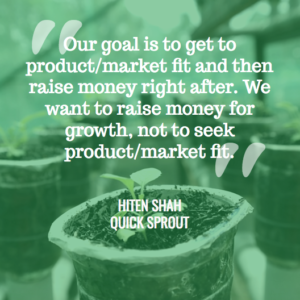
Our goal is to get to product/market fit, at least the first pass at it, and then, raise money right after that, and raise it for growth, not raise it for seeking product/market fit.
What I like to say about David is he’s Grandpa. He’s been building software for 20 years. I’ve been building software for about 13, so he’s definitely got that on me. I can’t raise money like he can on no deck or anything like that. Most of us can’t.
Alison: Maybe in seven years.
David: Yeah.
Hiten: Maybe in seven years, right. I’ll be Grandpa, and I don’t know you’ll be dead, right?
David: I’ll be dead by then.
[laughter]
David: I’ll be dead.
Alison: In SaaStr 2023, you can tell us.
David: Is this not the last SaaStr?
Hiten: SaaS is dead, right?
Alison: I’m going to have to move to Moscone or something. David, you have a lot of money. How does that impact your focus on developing product? What are you doing differently this time, because presumably the last couple of companies you started, you did not start with a $15-million bank account.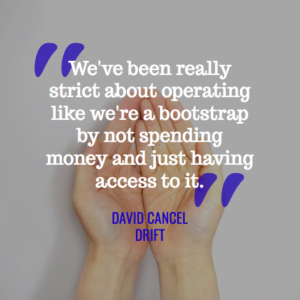
David: No. I started Performable with three million dollars and Compete with six , so a lot different. It gives you an opportunity to make more mistakes, because you have this money. We’ve been really strict about operating like we’re a bootstrap, not spending money, just having this access to money.
Our strategy was, of course, we raised this money pretty early. We thought we were going to need access to capital, because we all know how SaaS models work. We’re in the SaaS business. We’re going to need money. We can control how we build the product. We can control cost within the business.
What we can’t control is the macro and kind of raising, how the funding environment’s going to change. Don’t kick a gift horse in the mouth, right? We took the money and basically sat on it. Our investors joke around that we’re on the 10-year burn at this point. We will use the money to accelerate, but we’re still early.
Alison: Got it. Both of you are product founders. It sounds like a lot of people in here. Are you hiring product people? Let’s talk a little bit about product organization. In about five minutes, we’ll open it up for questions, so start thinking about any questions that you might have. What is your product organization look like, and what are some of the things that you hire for?
David: We’re both product guys. All my companies have pretty much been the same where it’s most of the early team is just product people, largely engineers, a few maybe designers, and maybe one other product person besides myself.
Over time as we’re getting to fit, and we’re understanding how the model works, then we’re bringing people on the marketing and sales side if we need it. I’d say one thing looking back is I think I brought in marketing and sales, I should have brought them in earlier.
That’s probably our blind spot as product people is just to always hire more and more engineers, because bringing them early, it wasn’t even a revenue thing. It was more of a different set of eyes and a different learning, that you’re learning from the market when you have people talking to a different audience in a different way, and maybe talking to more people each day.
At Performable, we did this test where we went to market as a freemium product. Most of our customers are freemium. Then I hired one salesperson, only as a purist experiment. We knew what the model looked like from a freemium standpoint.
I said, “I don’t know anything about inside sales.” I had done enterprise sales before. I said, “Let me hire one inside salesperson. Maybe she works for two to three months and maybe there’s nothing there.”
She was amazing in that we didn’t have anything. We didn’t have leads for her, materials. We didn’t have any… She just walked in, and I thought it was the best thing ever.
It worked from an inside sales perspective, but the reason that I thought it was great was it accelerated our learnings, because she was having 50 conversations every day, and we were all sitting in one room just hearing what she was saying, and what would work.
What would get someone to stay on the phone? What would cause someone to instantly hang up? Then we started to change our messaging and positioning based on the exact words that she was using, the hooks that were working.
We were like most product people and engineers, obsessed about A/B testing. We built an A/B testing product, obsessed around data, but sample size takes a long time to get to anything significant, and we were able to hack that by just listening to her work on the phone.
Alison: Yes, that sounds valuable. Super valuable. Hiten, how about from your standpoint, about in terms of building the product organization?
Hiten: Early stage I think I would hit on one of the main things David said, which is we’re designed around learning, so today, every day, I’m personally working with our product designer, because it’s very early, to figure out what this product needs to be, what we should be doing, the copy, the flows, the kind of thesis around it, all maximized around learning.
We’ve thrown out probably 30, 40 experiments already, in all different ways, to figure out what we need to build. The criteria for us on product teams early on is product designer, really just what most people would call a UX, UI designer, and at least one or two engineers, but those folks are mostly more generalists than specialists so that we can rapidly iterate.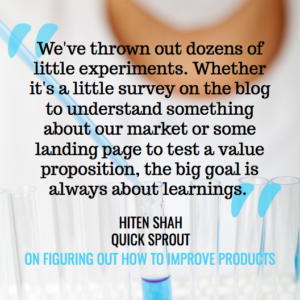
Like I said, we’ve thrown out dozens of little experiments, whether it’s a little survey on the blog to understand something about our market, or some landing page to test a value proposition, but the big goal is always about learnings.
We found that early on when you don’t need to scale product, meaning you don’t need to hire more engineers or build more features, because you don’t know what to build, keeping the team super small and very generalist-specific has been great.
The one difference between David and I is I’m essentially a marketer first, and so is my co-founder, and I’ve learned how to be all about product. I would say that I’m always learning, but the marketing things and stuff like that aren’t of much interest to us to bring on, because my co-founder and I are pretty good at that, and we have a bunch of traffic and all that.
We tend to augment ourselves with engineers and designers, because neither of us do either of those things at all. That’s been really helpful. The key learning for us is even as you grow, you want to optimize your team around learning, and staff it accordingly.
For example, if we discover that…I’ll give actually a really good example here. I consider customer support product early on, so in all of the products we’ve built, I’ve run support myself for the first, who knows how long.
The shortest time I ran it was about six months at KISSmetrics. At Crazy Egg, when we built a product I ran it for two years. The reason is, I’m head of product. I have to go make sure everything’s working, and I understand the learnings.
That was the fastest way to get it, because most of them early on came in from support, and now there’s a whole bunch of great tools to make all that easier, including Drift, so you can have chats, announcements, all kinds of stuff all in your app.
We tend to use those tools so that even though I might be founder, CEO, and doing a lot of product stuff I’m still able to answer all of those support requests, usually on my phone.
David: We’ve done the same thing, which is whole company support. Everyone does support, especially the engineers, because that’s how things get done the quickest. When engineers are actually hearing the problem three times, it gets fixed, versus Hiten and I trying to convince them to drug deal our way into getting them to do something.
Hiten: Yeah, when we were competing that’s one thing I learned from him. Our engineers weren’t doing support, and I believe he was able to solve customer problems faster with the team he had, with that philosophy, than we were. That’s when we started shifting some of that stuff. That’s a critical point.
Alison: That’s great. Now let’s open it up for questions. I think there’s some floating mics. I see a hand over there, so I’m going to start over there.
Audience Member: Hey, guys. Before you’ve reached product/market fit, how do you know how long to persist in continuing with your vision versus pivoting or deciding that this is a failed experiment?
[laughter]
Alison: I don’t know if everybody heard the question he asked. “How long before you reach product/market fit, how long do you continue to persist before pivoting or just calling it a day?”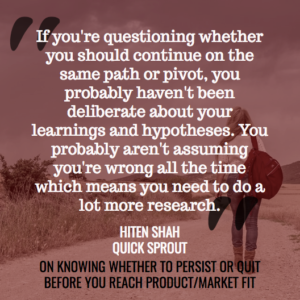
Hiten: I’m going to start. I’m sure you have a lot to add. If you’re in a situation where you’re questioning that, you probably haven’t been deliberate about your learnings. You haven’t been deliberate about your hypothesis and what you’re trying to prove or disprove. You probably aren’t assuming you’re wrong all the time.
The problems I see when someone’s challenged with that tend to be they haven’t been deliberate about what they’ve been trying to learn, and they’ve just been building a bunch of product. In that scenario that sounds like what you’re describing, I’d go get research.
I’d go talk to existing users, customers. I’d go try to double down on the learnings, even if you didn’t do them along the way, so you can really figure out how to move forward in some educated way or some learning-based way, instead of just blindly moving on.
David: Yeah, this is why I think having this idea or framework that you’re always wrong is so important, because when I talk to most founders, they ask the same question, and what’s behind that is that they’ve probably been going down some path for a long time before figuring out, “Oh, wait, something’s wrong, and should we pivot or not?”
Most people look at the stuff that I’ve done, and they say, “Wow, you pivot a lot.” I’m like, “No, our approach is like we’re in a constant, every single day learning mode and these are not pivots that we’re doing.”
We’re not working on something for a long time. We’re going zigzagging each day. That’s how we’re learning. We never get to this big epic moment that says, “Oh, we need to pivot.” Every day we’re learning along the way.
Hiten: We used to do it that way, the old way, where we would pivot it, and KISSmetrics was built that way, but I’ll give you a timeline when we changed. The first product took six months. The second product took nine months. These were all two pivots. The third one took 30 days to build.
Then we went in your mode, which is build it in 30 days and then start iterating it. That’s actually when we hit it, compared to thinking of it as massive big work in pivots.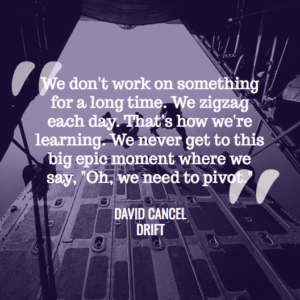
Alison: Got it. Super helpful, thanks. Other questions.
Audience Member: Hey, when you guys are developing, let’s say you’re in a SaaS business developing a market. You’ve got a great sales team, a great marketing team. You’ve got that demand. It’s pulling in new customers.
Those customers go live on your platform, and you’re trying to figure out their engagement, their activation, how much traction they’re actually getting, a sold customer’s getting on your platform. How do you guys think about breaking out those activation numbers?
I didn’t really hear much about…I heard about measuring product/market fit by revenue, but let’s say that revenue actually comes before that first meaningful interaction.
If you start thinking about the first meaningful interaction after that sales event, how would you guys start thinking about, “Well, we’re developing this market. We want, what, 30, 40, percent of our customers to be getting a lot of utilization and maybe following a power law there.”
How should we be thinking about this, if we’re not using Quick Sprout to develop something we know is going to be a great market for you guys, but where we’re pushing a new idea forward?
Alison: Answering about how engagement really factors in.
David: My view is it depends on the business, and so it’s almost like the last question. I think a lot of people hear about 30 to 40 percent or some number, some range, and then they wonder why they sold something, “We’re not getting 30 to 40 percent engagement.”
It depends on the business. I’ve seen businesses that are episodic like a SurveyMonkey where it’s going to take you years before you understand how your users actually use that product.
We did a product that was email-based that had no usage within the app, because by design, you don’t want to go log in. The way that you’re using it is when you get an email and when you read that email, so my view is that it really depends on your product. You can’t have some arbitrary way of measuring or benchmarking yourself on activation.
Alison: Got it. Hiten, how do you think about engagement?
Hiten: Yeah, if you’re in a situation where you’re able to get people to pay before they use, then it’s OK. You have great sales and marketing and all that stuff to get the sale, but then you’re almost pushing the hard problem to “They’ve already paid, and now we’re trying to deliver on paid value,” on the fact that they paid, and trying to understand how to keep them.
To me the answer is figure out what makes sense in terms of retention on your business, and start measuring on that, and start measuring indicators that lead to retention, and then there’s going to be outliers.
If it’s a lot of email activity, then open rates are retention. If it’s a longer term cycle like SurveyMonkey, then you have to wait longer, so it’s all about digging through the learnings and what are proxies for retention? Essentially in a business, if you can’t retain people, whether it’s free or paid, you don’t have a business. You’re not going to grow your business at all.
Alison: Thanks. I think that’s a wrap. Let’s have a big round of applause for David and Hiten.
